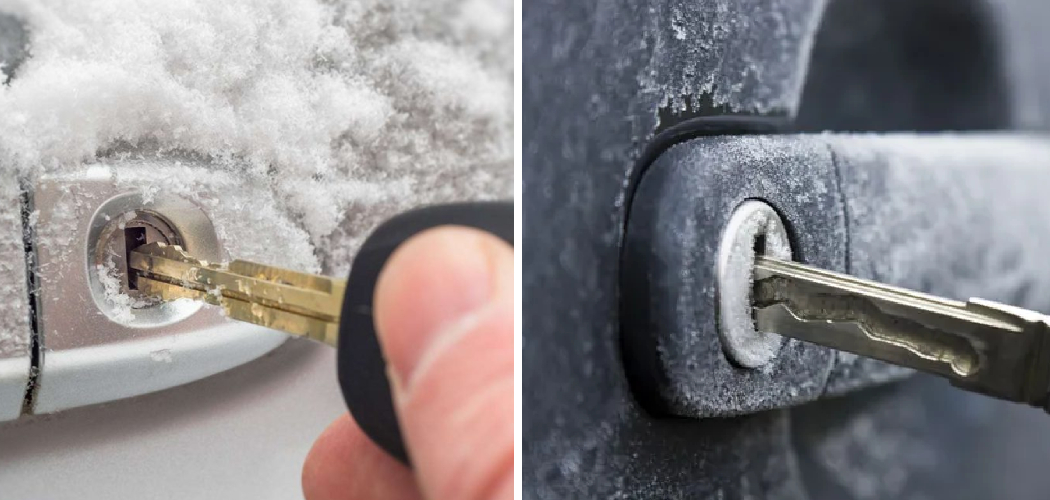Dealing with a frozen door lock can be frustrating, especially during the harsh winter months. It can prevent you from entering your home or car, leaving you stranded outside in the cold. While it may seem impossible to unlock a frozen door lock, you can try some simple solutions before calling a locksmith.
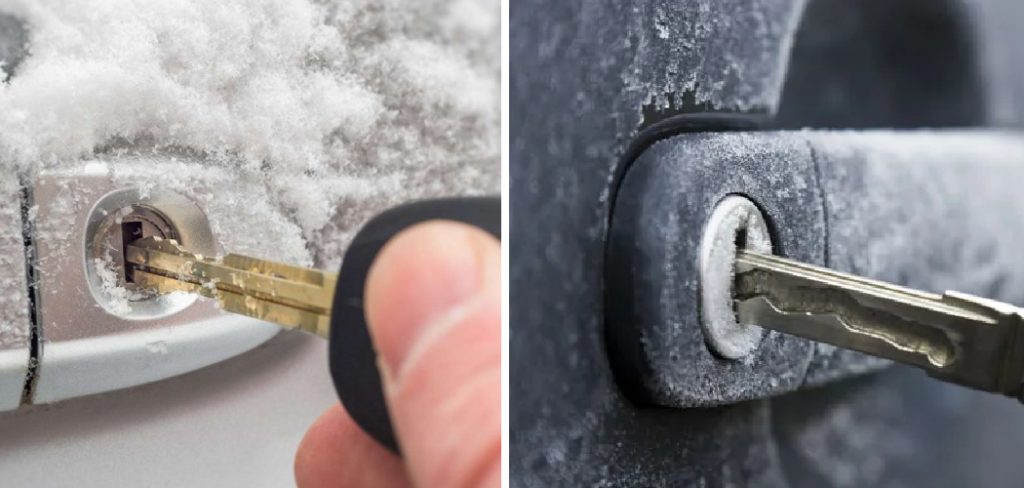
In this guide, we will discuss the common causes of a frozen door lock and provide step-by-step instructions on how to unlock a frozen door lock using various methods. By following these tips, you can save time and money while effectively solving the issue. So, let’s get started!
Understanding the Causes of Frozen Door Locks
A door lock can become frozen for various reasons, such as extreme temperatures, moisture buildup, or physical damage. During cold weather, condensation can form inside the lock mechanism, freezing and preventing the key from turning.
Additionally, if your door lock has been exposed to water or rain, it can freeze in low temperatures. Sometimes, a damaged or worn-out lock can also cause freezing, as it may not function properly. Identifying the root cause of the frozen lock before attempting any unlocking methods is essential.
11 Best Methods on How to Unlock a Frozen Door Lock
1. Use a De-Icing Spray:
A de-icing spray is one of the easiest ways to thaw a frozen door lock. These sprays are specifically designed to melt ice and frost, making turning your key easier. Apply the spray to the keyhole and wait a few seconds before attempting to unlock the door. A lock lubricant after the de-icing spray can help prevent future freezing. If you don’t have a de-icing spray, you can also use a hairdryer to warm up the lock.
2. Heat up the Key:
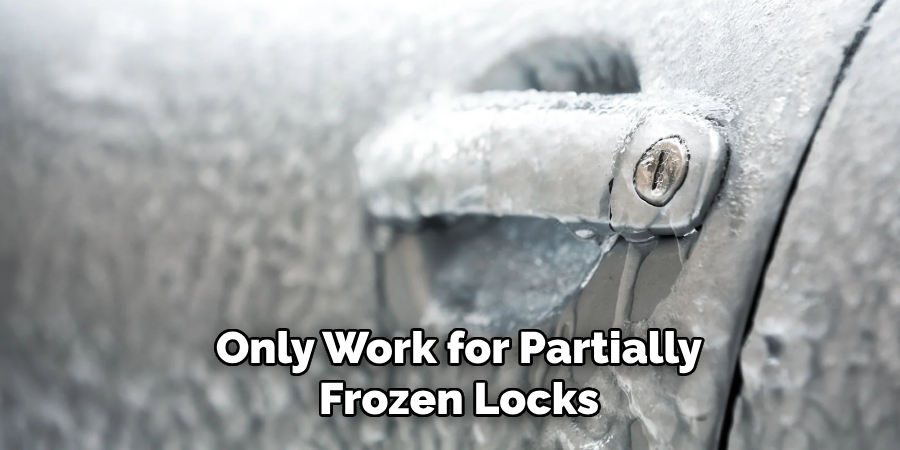
If you don’t have a de-icing spray, another option is to heat up your key with a lighter or match before inserting it into the lock. The heat will help melt any ice or frost inside, making turning and unlocking the door easier.
If you try this method, be careful not to burn yourself or damage your key. Use a metal key instead of a plastic one if possible, as it can withstand the heat better. This method may only work for partially frozen locks and should only be used as a last resort.
3. Use a Lock De-Icer:
Like de-icing sprays, a lock de-icer is another product designed specifically to thaw frozen door locks. It comes in the form of a small tube with a narrow nozzle that can be inserted directly into the keyhole. Squeeze the de-icer into the lock and wait a few moments before attempting to unlock the door. A lock de-icer is also recommended as a preventive measure during winter.
4. Try Graphite Powder:
Graphite powder is a dry lubricant that can help unfreeze door locks by reducing friction and making it easier to turn the key. Apply a small amount of graphite powder into the lock and gently insert and remove the key to distribute it evenly. Do not use any other type of lubricant, such as oil or WD-40, as they can attract dust and debris, making the lock more likely to freeze.
5. Use a Plastic Card:
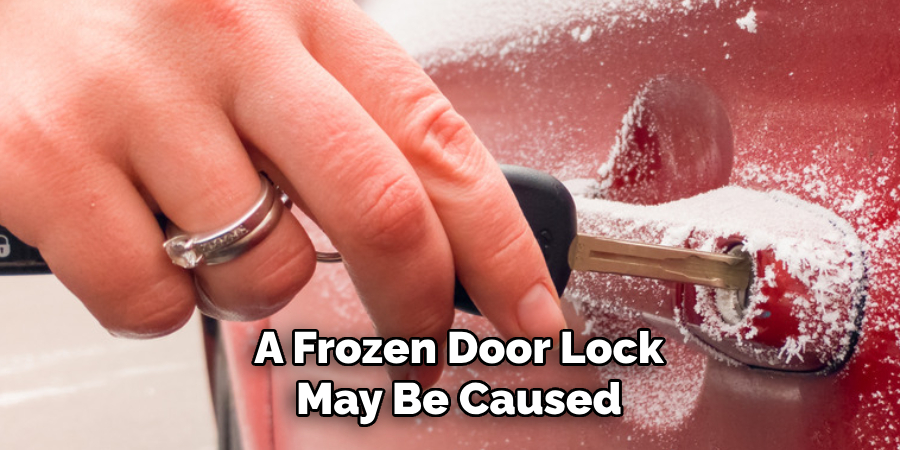
In some cases, a frozen door lock may be caused by a misaligned locking mechanism. Using a plastic card can help push the pins back into place and allow the key to turn.
Insert a thin plastic card between the door and the frame, above or below the lock, and gently wiggle it in while turning the key. This method may take some practice and may only work for some locks. This method should also be used cautiously, as it may damage the locking mechanism.
6. Apply Pressure on the Key:
If your key is stuck in the lock and won’t turn, apply gentle pressure while turning to unfreeze the lock. This method works better if the frozen lock is caused by ice or frost rather than a misaligned mechanism or a damaged lock. Be careful not to apply too much force, as it may break the key or damage the lock. This method may take some time and patience to work.
7. Use a Key Extractor Tool:
If your key is broken or stuck inside the lock, you can use a key extractor tool to remove it. These tools are specifically designed for this purpose and can be purchased at hardware stores. Follow the instructions provided with the tool carefully, as improper usage can damage the lock further. Using this method as a last resort is recommended.
8. Spray with Rubbing Alcohol:
Rubbing alcohol can also be used to unfreeze door locks, as it has a lower freezing point than water. Spray some rubbing alcohol into the keyhole and wait for it to dissolve any ice or frost. After a few moments, try turning the key again. This method may not work for extremely frozen locks and should be used cautiously, as rubbing alcohol can be flammable.
9. Use Hot Water:
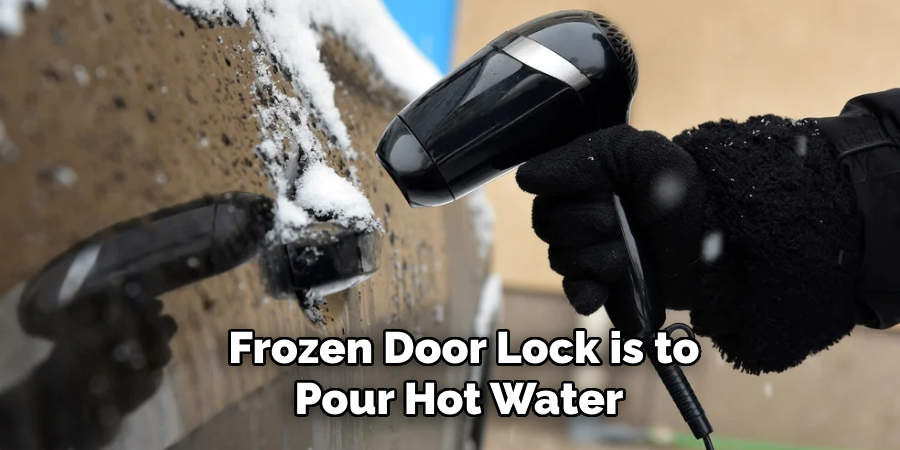
Another way to thaw a frozen door lock is to pour hot water. However, this method should be used carefully, as the sudden change in temperature may cause the lock to crack or break. Ensure the water is not too hot, and pour it directly onto the lock. Use a towel to dry the key before inserting it into the lock. Using this method too frequently may also damage the lock.
10. Try a Blow Dryer:
If you can access a blow dryer, you can use it on its lowest setting to warm up and melt any ice or frost inside the lock. Make sure to hold the dryer at least six inches away from the lock and continuously move it around for even heating. After a few minutes, try turning the key to unlock the door. This method may only work for partially frozen locks and should be used cautiously, as too much heat can damage the lock.
11. Seek Professional Help:
If all else fails, it may be best to seek professional help from a locksmith. They have the necessary tools and expertise to safely unfreeze and repair your door lock. It is recommended to have a locksmith’s contact information on hand in case of any emergencies, such as a frozen lock during extreme weather conditions.
Following these methods can help you successfully unlock a frozen door lock. Remember to always take precautions and avoid using excessive force or heat, as it may cause further damage. Regular maintenance of your locks, such as applying a lock lubricant before the winter season, can also prevent future freezing. Stay safe and warm during those cold months!
Additional Tips and Tricks to Unlock a Frozen Door Lock
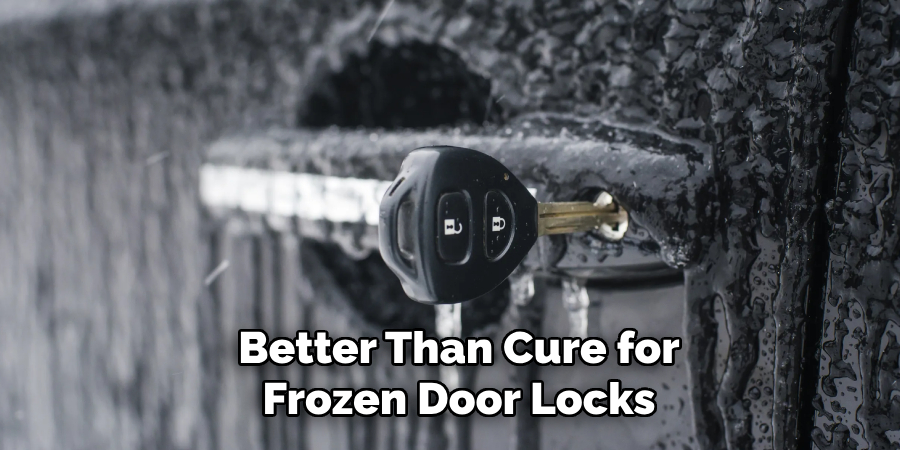
1. If you cannot unlock a frozen door lock using any of the abovementioned methods, try using a hairdryer. Direct the hot air towards the keyhole and surrounding area for a few minutes, and then try inserting the key again.
2. Another trick is to use hand sanitizer or rubbing alcohol on your key before inserting it into the lock. These substances have a low freezing point and can help melt any ice that may be causing the lock to freeze.
3. If you have a de-icer spray, you can use that on the lock to help thaw out any frozen components. However, be careful not to get the spray on your skin or in your eyes.
4. Prevention is always better than cure for frozen door locks. To avoid this problem in the future, you can use a silicone spray or graphite lubricant on your locks to prevent them from freezing.
5. During colder months, try to keep your key and lock dry by using an umbrella or covering the lock with a plastic bag when it’s raining or snowing.
6. If you cannot unlock your door due to a frozen car door lock, you can use a lighter or match to heat up the key before inserting it into the lock. Just be careful not to burn yourself.
7. If none of these methods work and you can still not unlock your door, it may be time to call a professional locksmith for assistance. They will have the necessary tools and expertise to safely and effectively unlock your frozen door lock.
8. Additionally, it is always a good idea to have spare keys on hand in case of emergencies like a frozen door lock. Keep them in a safe and easily accessible place.
9. Lastly, make sure to regularly maintain and clean your locks to prevent any buildup or malfunctions that could lead to a frozen lock. This includes removing any debris or dirt from the keyhole and using lubricant as needed.
Following these tips and tricks can help you unlock a frozen door lock without causing damage or harm. Always be cautious when attempting to thaw out a frozen lock, and never use excessive force that could break the key or damage the lock. Stay prepared and proactive to avoid encountering this issue in the future.
So, it is always better to keep yourself updated with tips and tricks to tackle any unexpected situations. Taking proper care of your locks ensures they function smoothly throughout the year, even during harsh weather conditions. Remember, prevention is key when it comes to a frozen door lock! Happy unlocking!
Things You Should Consider to Unlock a Frozen Door Lock

1. When a door lock is frozen, you should first remain calm and avoid panicking. Panicking will only worsen the situation and may lead to damage or complete lock malfunction.
2. Another thing to consider is the cause of the frozen lock. If the temperature outside is extremely cold, it could be the reason why your lock is frozen. In such cases, use a hairdryer or warm water to thaw the ice and unfreeze the lock.
3. If your door has a keyhole, you can use de-icing spray or rubbing alcohol to melt the ice. However, make sure not to use any flammable substances as they may pose a fire hazard.
4. If you cannot access de-icing spray or rubbing alcohol, you can try heating up your key with a lighter or match and then inserting it into the lock. This might provide enough heat to melt the ice and unlock the door.
5. Some door locks have a built-in heating mechanism or feature, which can be activated by inserting a key and turning it to the “unlock” position. This can also help melt the ice and unlock the frozen lock.
6. It is important to keep your door lock well-lubricated, especially during cold weather, to prevent it from freezing. Use a graphite lubricant or silicone spray to keep the lock mechanism moving smoothly.
7. If none of the above methods work, you can use a de-icer tool designed to unlock frozen locks. These tools are easily available at most hardware stores and can be used by inserting them into the keyhole and turning it like a key.
8. It is always advisable to have spare keys in case of a lockout situation. Keep them in a safe and easily accessible place so you do not have to deal with a frozen lock.
9. Regularly check the condition of your door lock and replace it if necessary. Old or damaged locks are more susceptible to freezing and may need professional maintenance or replacement.
10. If you live in an area with extreme weather conditions, consider investing in a keyless entry system or a smart lock that can be controlled remotely. This eliminates the risk of dealing with frozen locks and provides easy access to your home.
Following these tips can help you unlock a frozen door lock without damaging the lock or door. Remember, always prioritize safety and consider seeking professional help if necessary. Keeping your locks well-maintained and using preventive measures can also prevent future instances of frozen locks. Stay prepared and stay safe!
Common Mistakes to Avoid for Unlocking a Frozen Door Lock
1. Using Excessive Force:
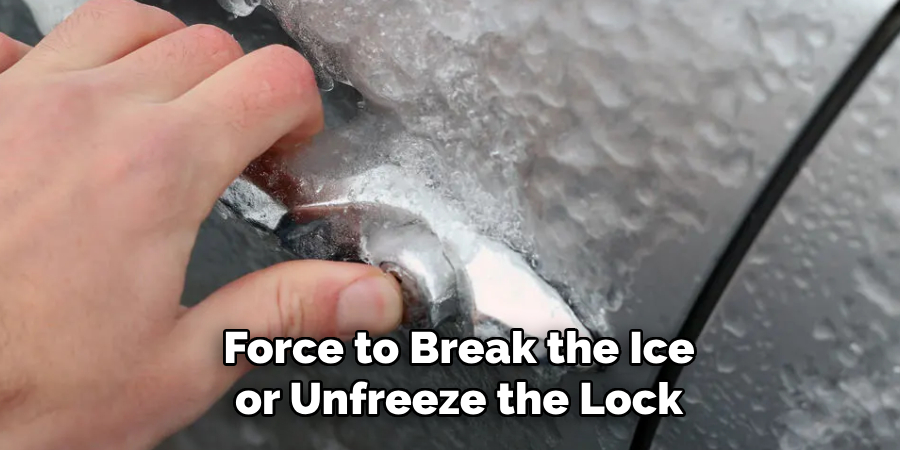
When faced with a frozen door lock, many people’s first instinct is to use excessive force to break the ice or unfreeze the lock. However, this can cause more harm than good and may damage the lock mechanism or key. It is important to remember that locks are designed to withstand a certain amount of force, so using excessive force may lead to costly repairs.
2. Pouring Hot Water:
Another common mistake people make when trying to unlock a frozen door lock is pouring hot water on the lock to melt the ice. While this may seem like a quick and easy solution, it can actually do more harm than good. The sudden change in temperature can cause the lock mechanism to expand and contract, making it difficult or even impossible to turn the key.
3. Using Household Lubricants:
Some people may use household lubricants such as WD-40 or cooking oil to unfreeze a door lock. However, these products can attract dust and dirt, ultimately worsening the problem by clogging the lock mechanism. It is best to avoid using any lubricant on a frozen lock. This also applies to using hand sanitizer or any other alcohol-based product as a quick fix.
4. Ignoring the Weather Forecast:
One of the most common mistakes leading to a frozen door lock is not paying attention to the weather forecast. This is especially true for those living in colder climates with common freezing temperatures. It is important to monitor the weather and take preventative measures, such as using a lock de-icer or covering the lock with a plastic bag, to avoid getting locked out.
5. Neglecting Regular Maintenance:
Prevention is key to avoiding a frozen door lock. Refrain from regular maintenance to avoid them freezing up in colder temperatures. It is important to clean and lubricate your door locks at least twice a year to ensure they are functioning properly. This will not only prevent freezing but also extend the lifespan of your locks.
6. Not Having a Spare Key:
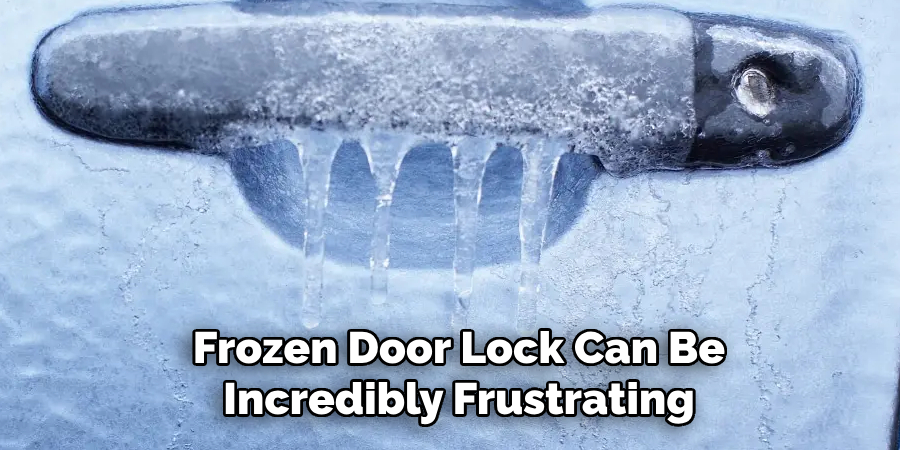
Getting locked out due to a frozen door lock can be incredibly frustrating, especially if you do not have a spare key. It is always important to have a spare key available, whether it is kept with a trusted neighbor or hidden in a secure location nearby. Having access to a spare key can save you time and hassle.
Avoiding these common mistakes can prevent a frozen door lock from becoming a major inconvenience. Always use gentle force, avoid household lubricants, and stay on top of regular maintenance to keep your locks functioning properly year-round. And remember to have a spare key handy, just in case!
Conclusion
Knowing how to unlock a frozen door lock can save you time and frustration in emergency situations. It is important to always have a backup plan for entering your home or car, especially during the winter months when frozen locks are more common. If your lock does become frozen, try using one of the methods mentioned in this article to release it. If none of the methods work, it is best to seek professional assistance to avoid causing damage to the lock or door.

